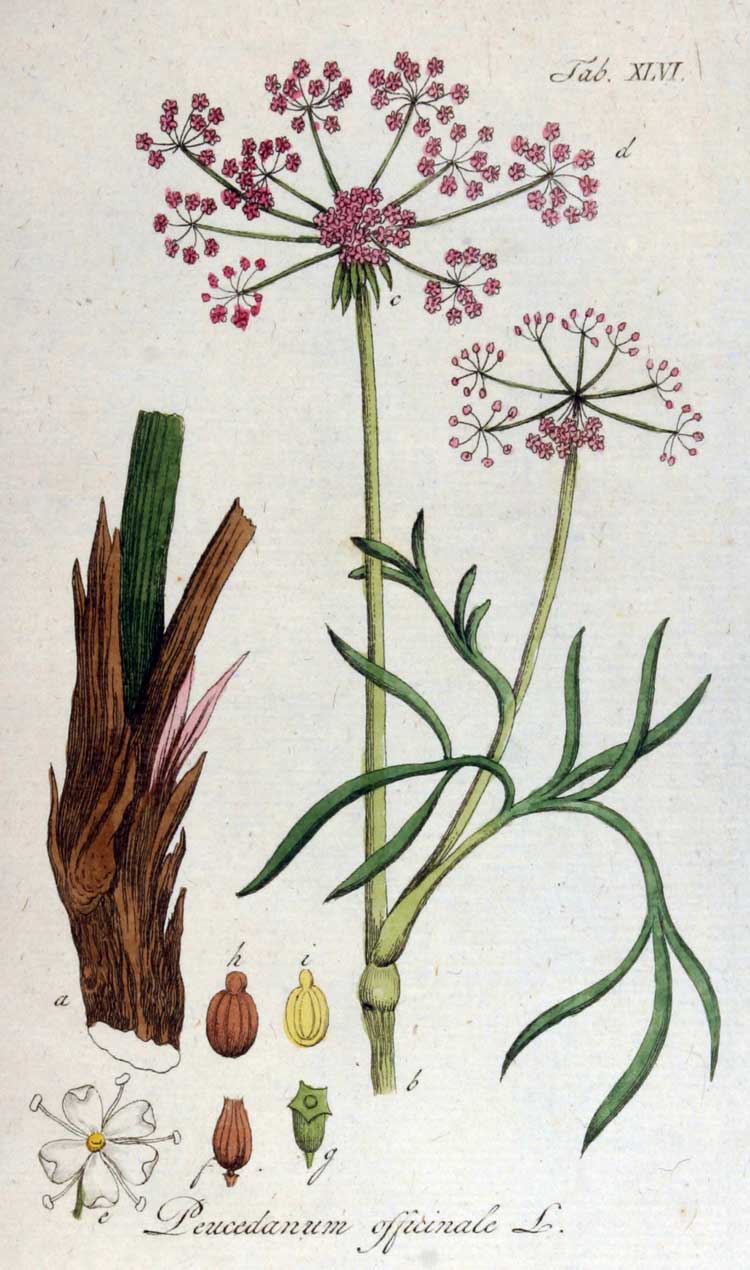
Peucedanum officinale
Classification System: APG IV
Superregnum: Eukaryota
Regnum: Plantae
Cladus: Angiosperms
Cladus: Eudicots
Cladus: Core eudicots
Cladus: Asterids
Cladus: Campanulids
Ordo: Apiales
Familia: Apiaceae
Subfamilia: Apioideae
Tribus: Selineae
Genus: Peucedanum
Species: Peucedanum officinale
Subspecies: P. o. subsp. brachyradium – P. o. subsp. officinale – P. o. subsp. paniculatum – P. o. subsp. vogelianum
Name
Peucedanum officinale L., 1753
Homonyms
Peucedanum officinale Bess. = Ferulago sylvatica subsp. sylvatica
Peucedanum officinale Thuill. = Peucedanum gallicum Latourr.
Peucedanum officinale Ucria = Hippomarathrum bocconei (Guss.) comb. ined.
References
Linnaeus, C. 1753. Species Plantarum. Tomus I: 245. Reference page.
Links
Hassler, M. 2018. Peucedanum officinale. World Plants: Synonymic Checklists of the Vascular Plants of the World In: Roskovh, Y., Abucay, L., Orrell, T., Nicolson, D., Bailly, N., Kirk, P., Bourgoin, T., DeWalt, R.E., Decock, W., De Wever, A., Nieukerken, E. van, Zarucchi, J. & Penev, L., eds. 2018. Species 2000 & ITIS Catalogue of Life. Published online. Accessed: 2018 Sep 08. Reference page.
International Plant Names Index. 2017. Peucedanum officinale. Published online. Accessed: Sep 15 2017.
The Plant List 2013. Peucedanum officinale in The Plant List Version 1.1. Published online. Accessed: 2017 Sep 15.
Tropicos.org 2017. Peucedanum officinale. Missouri Botanical Garden. Published online. Accessed: 15 Sep 2017.
USDA, ARS, Germplasm Resources Information Network. Peucedanum officinale in the Germplasm Resources Information Network (GRIN), U.S. Department of Agriculture Agricultural Research Service. Accessed: 2007-10-06.
Vernacular names
Deutsch: Echter Haarstrang, Arznei-Haarstrang
Ελληνικά: Πευκέδανο το φαρμακευτικό
English: hog's fennel, sulphurweed
español: aperauchi pequeño, ervato, herbatu, peucedano, rabo de puerco, servato, yerbatun
suomi: Rihmasuoputki
polski: Gorysz Lekarski
Peucedanum officinale is a herbaceous perennial plant in the family Apiaceae found mainly in Central Europe and Southern Europe.[2] It is also native to the UK, where it has the common names hog's fennel[3] and sulphurweed,[4] but it is a rare plant there, occurring only in certain localities in the counties of Essex and Kent. It was formerly also found near the town of Shoreham-by-Sea in the county of West Sussex, but has long been extinct there.
Habitat: rough grassland, clayey banks and cliffs near the sea. It is a glabrous perennial with stems up to 2 m in height, solid, striate, sometimes weakly angled, sparsely blotched wine red, surrounded by fibrous remains of petioles at the base and springing from a stout rootstock. The umbels of greenish-yellow flowers contrast pleasingly with the bushy, radiating mass of dark green, long-petioled leaves, which bear linear, sessile lobes, attenuate at both ends and having narrow, cartilaginous margins (i.e., individual lobes resembling blades of grass).[5]
Peucedanum officinale has been known as a medicinal plant in Britain since at least the 17th century and features in the herbals of Nicholas Culpeper (in whose day it was more plentiful, for he records it as growing abundantly on Faversham marshes) and John Gerard. Culpepper records the additional common names hoar strange, hoar strong, (compare German "Haarstrang", meaning hog's tail) brimstonewort and sulphurwort.
The long stout taproot - 'black without and white within' and sometimes 'as big as a man's thigh', as Gerard has it - yields, when incised in Spring, a considerable quantity of a yellowish-green latex, which dries into a gummy oleoresin and retains the strong, sulphurous scent of the root. This harvesting technique, and the product so obtained, very much recall those of two other medicinal umbellifers: Ferula assa-foetida and Dorema ammoniacum.[6][7] A decoction of the root of P. officinale is diuretic, sudorific, antiscorbutic and controls menstruation. Gummi Peucedani, the oleoresin derived from the drying of the root latex, has properties similar to those of Gum Ammoniac (the oleoresin derived from Dorema ammoniacum). Peucedanum officinale has also been used in veterinary medicine.[8]
References
"The Plant List: A Working List of All Plant Species". Retrieved 6 November 2014.
Flowers of Europe,a Field Guide Oleg Polunin, Oxford University Press 1969
BSBI List 2007 (xls). Botanical Society of Britain and Ireland. Archived from the original (xls) on 2015-06-26. Retrieved 2014-10-17.
"Peucedanum officinale". Germplasm Resources Information Network (GRIN). Agricultural Research Service (ARS), United States Department of Agriculture (USDA). Retrieved 6 November 2014.
"Umbellifers of the British Isles Tutin T.G. BSBI Handbook No.2. Pub. Botanical Society of the British Isles,1980.
A Modern Herbal Grieve,M.,Pub.1931,Jonathan Cape Ltd.,reprinted 1974 and 1975.
The Englishman's Flora,Grigson,G.,Pub. Readers Union Phoenix House Ltd.,London 1958.
A Dictionary of Plants Used by Man Usher, George. Pub. Constable, London 1974.
Retrieved from "http://en.wikipedia.org/"
All text is available under the terms of the GNU Free Documentation License

